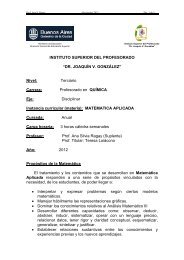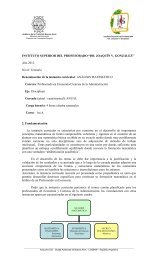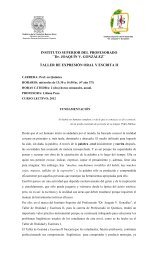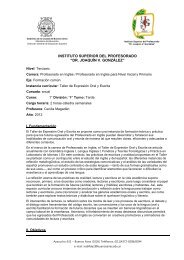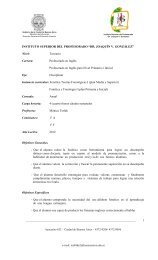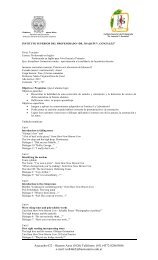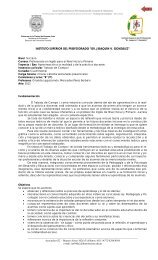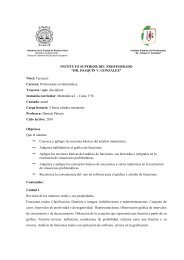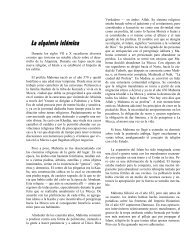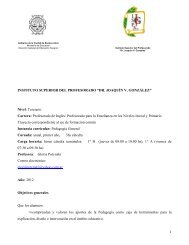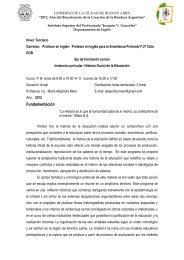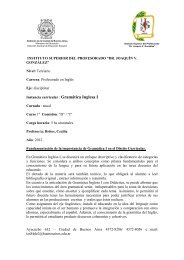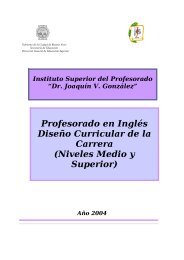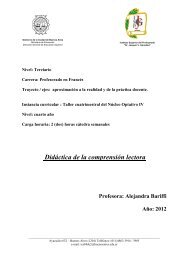Sesiones parale<strong>la</strong>s / Parall<strong>el</strong> sessionsKARMEL, JamesUn<strong>de</strong>rstanding Narrators, Un<strong>de</strong>rstanding Ours<strong>el</strong>ves:Teaching Oral History in a Military CommunityThis paper inclu<strong>de</strong>s an analysis of a history professor’s ext<strong>en</strong>sive <strong>oral</strong> historyproject, conducted in 2011. For the project, un<strong>de</strong>rgraduate stu<strong>de</strong>nts inan American military history c<strong>la</strong>ss split up into small groups and interviewedmilitary veterans and others with military backgrounds for a c<strong>la</strong>ss project.However, the project was more than a standard c<strong>la</strong>ss <strong>oral</strong> history project. Theproject also required stu<strong>de</strong>nts to reflect on the meaning of what they heardfrom narrators and what they learned about thems<strong>el</strong>ves from the interviews.How did the interviews change their perspectives, if at all, on the various warsor military ev<strong>en</strong>ts discussed? How did their perceptions of military veteranschange (if at all) or did their overall views of American military history change?The project took p<strong>la</strong>ce at a college located within a military community, andmany stu<strong>de</strong>nts have military connections. Stu<strong>de</strong>nts in the c<strong>la</strong>ss utilized the<strong>oral</strong> history to <strong>de</strong>v<strong>el</strong>op a more complex un<strong>de</strong>rstanding about both the pastand their own i<strong>de</strong>ntities within a community and national context. Unlike as<strong>el</strong>f-contained c<strong>la</strong>ss <strong>oral</strong> history project, this project focused on the communityrole of the veterans and stu<strong>de</strong>nts as <strong>oral</strong> <strong>historia</strong>ns producing history whilesimultaneously exploring their own s<strong>el</strong>f-i<strong>de</strong>ntities and historical un<strong>de</strong>rstandings.The paper also explores connections betwe<strong>en</strong> the stu<strong>de</strong>nts’ <strong>oral</strong> historywork and <strong>la</strong>rger themes for perceiving the rec<strong>en</strong>t American military historyand compon<strong>en</strong>ts of a broa<strong>de</strong>r national narrative on this history. Finally, thepaper <strong>de</strong>scribes an “Oral History Educational Loop” based on the findings forthis project - a new tool for teaching <strong>oral</strong> history.——————————————————————————————————————————————C<strong>en</strong>tro Cultural <strong>de</strong> <strong>la</strong> Cooperación——————————————————————————————————————————————Subtema / Subteme 5Memorias, política y militancias / Memories, politicsand militancies• Experi<strong>en</strong>cias <strong>de</strong> lucha política: movimi<strong>en</strong>tossociales, ONGs, grupos políticos, construcción <strong>de</strong>lmovimi<strong>en</strong>to feminista / NGOs Political Groups,Political Ag<strong>en</strong>cy and IndividualsSa<strong>la</strong> Jacobo Laks - Mesa / Session 25Coordinan / Chair: Antonio Mont<strong>en</strong>egro y Mariana Mastráng<strong>el</strong>o——————————————————————————————————————————————IZQUIERDO, Roberto“Una ceremonia popu<strong>la</strong>r y dos mom<strong>en</strong>tos históricos”.Las ofr<strong>en</strong>das fl<strong>oral</strong>es y guardias perman<strong>en</strong>tesfr<strong>en</strong>te al busto <strong>de</strong> Eva Perón <strong>en</strong> <strong>la</strong>s fábricas porteñas,1952-1956According to our hypothesis, the worship to the figures of Juan Perón and EvaPerón, though induced at first by a system of political official propaganda thatwas recognizing in the worship to the personality a constitutive ess<strong>en</strong>tial <strong>el</strong>em<strong>en</strong>t,it was nourished also of the symbolic and cultural spontaneous practiceof the workers and of the secondary c<strong>la</strong>sses, that they re-mean actions, rituals,icons and messages come from the state power and from his propaganda <strong>de</strong>vice.Really, official culture and popu<strong>la</strong>r culture are formed as terms that areinflu<strong>en</strong>ced reciprocally, although the messages, icons and symbols come fromthe official propaganda address necessarily to the popu<strong>la</strong>r sectors, inclu<strong>de</strong>dthe working c<strong>la</strong>ss, for which they must adapt to his symbolic practices.ROMERA NIELFA, Juan Karlos1978ko Aste Nagusia: <strong>la</strong> irrupción <strong>de</strong> un nuevo imaginariocolectivo <strong>en</strong> un <strong>en</strong>torno festivo, <strong>de</strong> gran repercusión<strong>en</strong> <strong>el</strong> proceso <strong>de</strong> crítica a <strong>la</strong> transición pactada<strong>en</strong> España.En agosto <strong>de</strong> 1978 un ev<strong>en</strong>to festivo, <strong>la</strong> Aste Nagusia <strong>de</strong> Bilbao, primera SemanaGran<strong>de</strong> popu<strong>la</strong>r tras <strong>la</strong> dictadura, va a servir <strong>de</strong> cauce <strong>de</strong> expresión <strong>de</strong> unnuevo imaginario social, político y cultural cuyo sujeto histórico va a ser <strong>la</strong> g<strong>en</strong>eraciónjov<strong>en</strong> (nacidos <strong>en</strong>tre 1956 y 1964), es <strong>de</strong>cir, los que <strong>en</strong> 1978 contaban<strong>de</strong> catorce a veinte años.A través <strong>de</strong> una amplia docum<strong>en</strong>tación ( testimonios <strong>oral</strong>es, hemeroteca y bibliografía<strong>de</strong> tipo antropológico sobre <strong>la</strong> fiesta) int<strong>en</strong>taré exponer <strong>la</strong> sigui<strong>en</strong>tetesis: La irrupción <strong>de</strong> un nuevo imaginario colectivo <strong>en</strong> <strong>el</strong> <strong>en</strong>torno festivoy su exitoso <strong>de</strong>spliegue iconográfico van a significar un hito importantísimo<strong>en</strong> <strong>el</strong> proceso <strong>de</strong> transición <strong>de</strong> <strong>la</strong> dictadura fascista <strong>de</strong> Franco a <strong>la</strong> <strong>de</strong>mocracia,aportando una visión <strong>de</strong>l espacio público, <strong>de</strong> <strong>la</strong> acción colectiva y <strong>de</strong> <strong>la</strong>cultura popu<strong>la</strong>r, <strong>en</strong> es<strong>en</strong>cia, nueva, si bi<strong>en</strong> hay que analizar metabolizaciones<strong>de</strong> restos antiguos, interpretaciones <strong>de</strong> lo tradicional y lo contemporáneo, asícomo <strong>la</strong> vincu<strong>la</strong>ción que parece existir <strong>en</strong>tre <strong>la</strong> pert<strong>en</strong><strong>en</strong>cia a grupos primariosy <strong>la</strong> visión <strong>de</strong> <strong>la</strong> comunidad y <strong>de</strong>l espacio político que ti<strong>en</strong><strong>en</strong> estas cohortesjuv<strong>en</strong>iles.Algo nuevo apareció <strong>en</strong> <strong>la</strong> esc<strong>en</strong>a festiva, <strong>en</strong> medio <strong>de</strong> un proceso político pactadoque <strong>de</strong>sembocaría <strong>en</strong> <strong>la</strong> promulgación <strong>de</strong> <strong>la</strong> Constitución <strong>de</strong> 1978, aún vig<strong>en</strong>te<strong>en</strong> España, y <strong>el</strong> Estatuto <strong>de</strong> Autonomía vascongado <strong>de</strong> 1979, subsidiario<strong>de</strong>l or<strong>de</strong>n constitucional m<strong>en</strong>cionado. El verda<strong>de</strong>ro hilo conductor <strong>de</strong>l nuevouniverso simbólico va a ser lo vasco, interpretado y asumido <strong>de</strong> una manera híbrida,y <strong>la</strong> aus<strong>en</strong>cia notoria <strong>de</strong> todo <strong>el</strong> imaginario republicano, que al no habersido exitosam<strong>en</strong>te transmitido, se <strong>en</strong>contraba inactivo, aus<strong>en</strong>te e ignorado <strong>en</strong><strong>la</strong> g<strong>en</strong>eración jov<strong>en</strong> <strong>de</strong> <strong>la</strong> Aste Nagusia <strong>de</strong> 1978.In August 1978 a festival ev<strong>en</strong>t, Bilboko Aste Nagusia, the first popu<strong>la</strong>r majorweek after the dictatorship, is going to be an expressive way of a new social,political and cultural imaginery whose historical subject is going to be theyouth g<strong>en</strong>eration (born betwe<strong>en</strong> 1956 and 1964) , i.e., the ones who were betwe<strong>en</strong>14-20 years old in 1978.Thanks to an ext<strong>en</strong>sive docum<strong>en</strong>tation (<strong>oral</strong> testimonies, news paper archiveand anthropologic, bibliographies about the feast). I will try to expose thefollowing thesis: The irruption of a new collective imaginery in the festiva<strong>la</strong>tmosphere and its successful iconographic <strong>de</strong>ploym<strong>en</strong>t are going to mean avery important milestone in the transitional period process from Franco’s fascistdictatorship to the <strong>de</strong>mocracy giving a vision of the public space, collectiveaction and popu<strong>la</strong>r culture, basically new, although transformations of anci<strong>en</strong>ttraces should be analysed, interpretations of the traditional and contemporaryways as w<strong>el</strong>l as the putative link betwe<strong>en</strong> the b<strong>el</strong>onging to primary groupsand the vision of the community and of the political space professed by thesesjuv<strong>en</strong>iles cohorts.Something new appeared in the festival sc<strong>en</strong>e, in the context of an agreed apolitical process which led into the <strong>en</strong>actm<strong>en</strong>t of the 1978 Constitution, still inforce in Spain, and the 1979 Statute of the Basque Autonomy, subsidiary of theabove m<strong>en</strong>tioned constitutional or<strong>de</strong>r.The really driving force of the new symbolic universe is going to be the Basque,interpreted and consi<strong>de</strong>red as an hybrid way and the remarkable abs<strong>en</strong>ce ofall the Republican imaginery which have not be<strong>en</strong> successfully transmitted, itwas inactive, missed and ignored in the young g<strong>en</strong>eration of the Aste Nagusia1978.The link betwe<strong>en</strong> the Basque culture and the left-wing nationalist policy, thesearch of the basics in the country si<strong>de</strong> world, perhaps, s<strong>el</strong>f-organization sawnby the youngster g<strong>en</strong>eration, special protagonist of the Aste Nagusia 1978 willbe the <strong>de</strong>cisive features of subsequ<strong>en</strong>t social, political, cultural, artistic andlinguistic success and failures.Cabral do Nacim<strong>en</strong>to, Alcilei<strong>de</strong>El movimi<strong>en</strong>to feminista <strong>en</strong> Recife y <strong>la</strong> ciudadaníapolítica: Un <strong>de</strong>bate <strong>en</strong> torno al sexismo <strong>en</strong> <strong>la</strong> políticarepublicana (1931-1934)Esta pres<strong>en</strong>tación analiza como <strong>el</strong> Movimi<strong>en</strong>to Feminista <strong>en</strong> Recife problematizó<strong>el</strong> sil<strong>en</strong>cio y <strong>la</strong> negación <strong>de</strong> los <strong>de</strong>rechos políticos a <strong>la</strong>s mujeres, durante <strong>la</strong>Primera República Brasileña instaurada <strong>en</strong> 1889. La Constitución Republicana<strong>de</strong> 1891 estableció <strong>el</strong> sexismo político al sancionar que ap<strong>en</strong>as los hombresalfabetizados, mayores <strong>de</strong> 21 años, serían consi<strong>de</strong>rados ciudadanos. Estratégicam<strong>en</strong>te,<strong>la</strong>s feministas focalizaron <strong>la</strong> conquista <strong>de</strong> los <strong>de</strong>rechos políticos,como posibilidad <strong>de</strong> alcanzar <strong>la</strong> igualdad civil y los <strong>de</strong>rechos sociales.La int<strong>en</strong>sa utilización <strong>de</strong> <strong>la</strong> pr<strong>en</strong>sa, <strong>de</strong> <strong>la</strong> radio y <strong>la</strong> fundación <strong>de</strong> periódicos yrevistas por <strong>la</strong>s feministas hab<strong>la</strong>ban <strong>de</strong> prácticas <strong>de</strong> libertad y <strong>de</strong> juegos <strong>de</strong>po<strong>de</strong>r, que buscaban re<strong>de</strong>finir <strong>la</strong>s re<strong>la</strong>ciones <strong>de</strong> género posibles <strong>en</strong> los marcos<strong>de</strong>l régim<strong>en</strong> <strong>de</strong>mocrático. Al final, ¿don<strong>de</strong> resi<strong>de</strong> <strong>la</strong> difer<strong>en</strong>cia <strong>en</strong>tre hombresy mujeres que alim<strong>en</strong>tan <strong>la</strong> exclusión fem<strong>en</strong>ina <strong>de</strong> <strong>la</strong> ar<strong>en</strong>a política? Ésa pareceser <strong>la</strong> cuestión fundam<strong>en</strong>tal colocada por difer<strong>en</strong>tes feministas <strong>de</strong> Recife y<strong>de</strong> otras capitales <strong>en</strong> <strong>el</strong> <strong>de</strong>bate sobre <strong>la</strong> exclusión <strong>de</strong> los espacios públicos <strong>de</strong><strong>la</strong>s <strong>de</strong>cisiones políticas. En Recife surgió, <strong>en</strong> 1931, una organización feministacon ese propósito: <strong>la</strong> Fe<strong>de</strong>ração Pernambucana para o Progresso Feminino, li<strong>de</strong>radapor Edwiges <strong>de</strong> Sá Pereira, poetisa, escritora, profesora e int<strong>el</strong>ectual<strong>de</strong> importancia <strong>en</strong> <strong>el</strong> esc<strong>en</strong>ario <strong>de</strong> <strong>la</strong> ciudad. Para <strong>el</strong><strong>la</strong>, <strong>la</strong>s reivindicaciones <strong>de</strong><strong>la</strong>s mujeres no <strong>de</strong>berían provocar “rec<strong>el</strong>os” <strong>de</strong> “perturbación social”, porquetodo sería realizado “<strong>de</strong>ntro <strong>de</strong> los límites <strong>de</strong>l programa”. Al final, <strong>la</strong> mujer nopret<strong>en</strong>día tomar <strong>el</strong> lugar <strong>de</strong> los hombres, como los incautos diagnosticaban,porque, según <strong>la</strong> feminista, “cooperar no era usurpar, completar no era anu-96
Sesiones parale<strong>la</strong>s / Parall<strong>el</strong> sessions<strong>la</strong>r, sustituir no era preterir. Bastarse a sí misma dignam<strong>en</strong>te, <strong>el</strong>evaba a <strong>la</strong> mujer,no disminuía al hombre”. Su discurso parecía proponer <strong>la</strong> horizontalidady <strong>la</strong> quiebra <strong>de</strong> <strong>la</strong> jerarquía <strong>en</strong>tre los géneros. Si <strong>el</strong> Movimi<strong>en</strong>to no combatió<strong>la</strong> naturalización <strong>de</strong> <strong>la</strong> difer<strong>en</strong>cia <strong>en</strong>tre los sexos, al m<strong>en</strong>os cuestionó sus presupuestosy <strong>de</strong>snudó <strong>la</strong> <strong>en</strong>trañada concepción <strong>de</strong> inferioridad <strong>de</strong> <strong>la</strong>s mujeresfr<strong>en</strong>te a los hombres.Necoechea Gracia, GerardoConverg<strong>en</strong>cia <strong>en</strong> punto crítico: <strong>la</strong>s izquierdas <strong>en</strong> <strong>la</strong>década <strong>de</strong> 1970 <strong>en</strong> MéxicoEl trabajo está basado <strong>en</strong> <strong>en</strong>trevistas con miembros <strong>de</strong> una organización política<strong>de</strong> izquierda, conformada alre<strong>de</strong>dor <strong>de</strong> una publicación, Punto Crítico.Esta organización inició <strong>en</strong> 1971 y se disolvió <strong>en</strong> 1989. La pon<strong>en</strong>cia explorarádos cuestiones. La primera, <strong>el</strong> orig<strong>en</strong> <strong>de</strong> los fundadores, muchos <strong>de</strong> <strong>el</strong>los prov<strong>en</strong>i<strong>en</strong>tes<strong>de</strong> <strong>la</strong>s Juv<strong>en</strong>tu<strong>de</strong>s Comunistas y <strong>de</strong>l activismo político estudiantil, eincluso estuvieron Presos a raíz <strong>de</strong>l movimi<strong>en</strong>to estudiantil <strong>de</strong> 1968. El segundoeje ti<strong>en</strong>e que ver con <strong>la</strong>s ligas inicialm<strong>en</strong>te establecidas con sindicatos, <strong>en</strong>particu<strong>la</strong>r con <strong>la</strong> l<strong>la</strong>mada T<strong>en</strong><strong>de</strong>ncia Democrática, y que a su vez conectabacon varias organizaciones originadas <strong>en</strong> <strong>el</strong> nacionalismo revolucionario <strong>de</strong>lmovimi<strong>en</strong>to car<strong>de</strong>nista. El trabajo indagará sobre los vínculos que Punto Críticopudo establecer con <strong>el</strong> movimi<strong>en</strong>to obrero y con <strong>la</strong>s discusiones que <strong>el</strong>lomotivó alre<strong>de</strong>dor <strong>de</strong>l sujeto revolucionario y <strong>de</strong> <strong>la</strong> i<strong>de</strong>ología nacionalista.Pozzi, Pablo A.Eso yo no lo viví. C<strong>la</strong>se, género y tradiciones locales<strong>en</strong> <strong>la</strong> construcción <strong>de</strong> una fu<strong>en</strong>te <strong>oral</strong>La construcción <strong>de</strong> una fu<strong>en</strong>te <strong>oral</strong>, y <strong>en</strong> este caso <strong>de</strong> una <strong>en</strong>trevista, chocacontra distintos obstáculos que <strong>de</strong>b<strong>en</strong> ser superados por <strong>en</strong>trevistador y <strong>en</strong>trevistado.<strong>Los</strong> contrastes <strong>de</strong> c<strong>la</strong>se, <strong>la</strong>s particu<strong>la</strong>rida<strong>de</strong>s <strong>de</strong> género, los significadosy significantes todos <strong>de</strong>b<strong>en</strong> ser consi<strong>de</strong>rados y tamizados a través <strong>de</strong> <strong>la</strong>“cultura ordinaria” <strong>de</strong> <strong>la</strong> zona <strong>de</strong> dón<strong>de</strong> provi<strong>en</strong><strong>en</strong> los sujetos <strong>de</strong> <strong>la</strong> <strong>en</strong>trevista.Cultura y tradición marcan fuertem<strong>en</strong>te c<strong>la</strong>se y género <strong>en</strong> <strong>la</strong> <strong>en</strong>trevista.En esta pon<strong>en</strong>cia se analizarán estos temas a partir <strong>de</strong> una <strong>en</strong>trevista con dosex presas políticas oriundas <strong>de</strong> Río Cuarto (Arg<strong>en</strong>tina), una prov<strong>en</strong>i<strong>en</strong>te <strong>de</strong> unafamilia obrera y <strong>la</strong> otra <strong>de</strong> sectores medios. El léxico, <strong>el</strong> imaginario, <strong>la</strong> estructura<strong>de</strong>l testimonio se v<strong>en</strong> fuertem<strong>en</strong>te recorridos por <strong>el</strong> conflicto <strong>en</strong> <strong>la</strong> visión <strong>en</strong>treambas, y <strong>en</strong>tre <strong>el</strong><strong>la</strong>s y <strong>el</strong> <strong>en</strong>trevistador, hombre y universitario. El resultadoes una riqueza <strong>de</strong> contrastes y <strong>de</strong> problemas metodológicos e interpretativosque resultan suger<strong>en</strong>tes para <strong>el</strong> investigador <strong>de</strong> <strong>la</strong> subjetividad obrera.LOIÁCONO, María Rosa y ECHEZURI, AdrianaOtras formas <strong>de</strong> participación y compromiso: <strong>el</strong> caso<strong>de</strong> <strong>la</strong> parroquia Santa Cruz <strong>de</strong> Bu<strong>en</strong>os AiresEn este trabajo se p<strong>la</strong>ntea que, durante <strong>la</strong> última dictadura militar sufrida porlos arg<strong>en</strong>tinos, se int<strong>en</strong>taron distintas formas <strong>de</strong> participación popu<strong>la</strong>r. Una<strong>de</strong> estas formas <strong>de</strong> participación se dio <strong>en</strong> <strong>el</strong> marco <strong>de</strong>l trabajo realizado por<strong>la</strong>s parroquias <strong>de</strong>l Tercer Mundo que predicaban <strong>la</strong> justicia social. Durante <strong>el</strong>inicio <strong>de</strong> <strong>la</strong> década <strong>de</strong> 1970 <strong>en</strong> muchas <strong>de</strong> <strong>el</strong><strong>la</strong>s se creía que <strong>el</strong> peronismo era <strong>la</strong>alternativa política para acce<strong>de</strong>r al cambio. Cuando <strong>la</strong>s Fuerzas Armadas interrumpieronese mom<strong>en</strong>to histórico con <strong>el</strong> <strong>de</strong>nominado “Proceso <strong>de</strong> ReorganizaciónNacional”, muchos militantes sintieron un vacío, dado que no fue fácil<strong>en</strong>contrar un espacio don<strong>de</strong> po<strong>de</strong>r volcar su compromiso i<strong>de</strong>ológico. Ese vacíofue cubierto <strong>en</strong> gran medida por esas parroquias. Entre todas estas, <strong>la</strong> SantaCruz fue y es emblemática, y es por este motivo <strong>el</strong> c<strong>en</strong>tro <strong>de</strong> nuestra investigación.Si bi<strong>en</strong> no se abordarán aquí los hechos tristem<strong>en</strong>te famosos ocurridos<strong>en</strong> dicha parroquia, es indudable que <strong>el</strong>los han <strong>de</strong>jado una hu<strong>el</strong><strong>la</strong> imborrable<strong>en</strong> <strong>la</strong> memoria colectiva <strong>de</strong> los sobrevivi<strong>en</strong>tes, los familiares, los vecinos, sinimportar si son r<strong>el</strong>igiosos o <strong>la</strong>icos.Nuestra int<strong>en</strong>ción es <strong>de</strong>mostrar cómo se suplió <strong>la</strong> falta <strong>de</strong> espacio participativo,qué pasó luego <strong>de</strong> <strong>la</strong> reapertura <strong>de</strong>mocrática y qué ocurre <strong>en</strong> <strong>la</strong> actualidad.Sabemos que es un objetivo ambicioso y complejo, a<strong>de</strong>más <strong>de</strong> ext<strong>en</strong>so.Si bi<strong>en</strong> hay mucha bibliografía re<strong>la</strong>cionada con <strong>el</strong> contexto <strong>de</strong> nuestro trabajo,creemos necesario (por no <strong>de</strong>cir imprescindible) recurrir a <strong>la</strong> metodología <strong>de</strong><strong>historia</strong> <strong>oral</strong>, dado que los testimonios <strong>de</strong> qui<strong>en</strong>es han estado y están <strong>en</strong> <strong>la</strong>parroquia son sumam<strong>en</strong>te valiosos para rescatar una parte importante <strong>de</strong>nuestra <strong>historia</strong> reci<strong>en</strong>te.MELO, Luiz ArgoloLa fe, <strong>el</strong> po<strong>de</strong>r y <strong>la</strong> vida <strong>en</strong> <strong>la</strong>s comunida<strong>de</strong>s eclesiales<strong>de</strong> base <strong>en</strong> Mutuípe – Bahia – Brasil (1975-2000)Este artículo ti<strong>en</strong>e como objetivo discutir <strong>la</strong> organización <strong>de</strong> <strong>la</strong>s Comunida<strong>de</strong>sEclesiales <strong>de</strong> Base (CEBs) <strong>en</strong> <strong>la</strong> Parroquia <strong>de</strong> Mutuípe - Bahía, Brasil <strong>en</strong>tre finales<strong>de</strong> <strong>la</strong> década <strong>de</strong> 1970 hasta principios <strong>de</strong> 2000. Se analizará también <strong>la</strong>participación <strong>de</strong> los animadores <strong>de</strong> <strong>la</strong> comunidad <strong>en</strong> estos procesos bases <strong>de</strong><strong>la</strong> fundación <strong>de</strong>l sindicato <strong>de</strong> trabajadores rurales y, posteriorm<strong>en</strong>te, <strong>en</strong> cuestionespolíticas partidistas.Las CEBs <strong>en</strong> <strong>la</strong> Parroquia <strong>de</strong> Mutuípe inserta <strong>en</strong> <strong>el</strong> contexto guiado por <strong>la</strong> IglesiaCatólica a través <strong>de</strong> <strong>la</strong> CNBB y los objetivos past<strong>oral</strong>es <strong>de</strong> <strong>la</strong> Diócesis <strong>de</strong> Amargosa,<strong>de</strong> <strong>la</strong> que pert<strong>en</strong>ecían. Las CEBs fueron reconocidas <strong>en</strong> <strong>la</strong> Confer<strong>en</strong>cia <strong>de</strong>Me<strong>de</strong>llín <strong>en</strong> 1968, como “una nueva manera <strong>de</strong> ser Iglesia”, y confirmadas <strong>en</strong>Pueb<strong>la</strong> <strong>en</strong> 1979. De este modo, <strong>la</strong>s comunida<strong>de</strong>s <strong>de</strong> base han llegado a cuestionary dar una “nueva forma” <strong>de</strong> <strong>la</strong> acción evang<strong>el</strong>izadora <strong>de</strong> <strong>la</strong> Iglesia Católica<strong>en</strong> Mutuípe, que a veces se basó <strong>en</strong> <strong>la</strong>s prácticas r<strong>el</strong>igiosas tradicionales, muchasveces conservadora. Es <strong>en</strong> esta tierra fértil y con <strong>el</strong> legado <strong>de</strong> <strong>la</strong>s motivaciones<strong>de</strong>l Concilio Vaticano II que brotan <strong>la</strong>s primeras experi<strong>en</strong>cias <strong>de</strong> <strong>la</strong>sCEBs <strong>en</strong> <strong>la</strong> Parroquia <strong>de</strong> Mutuípe.Las prácticas r<strong>el</strong>igiosas católicas han t<strong>en</strong>ido gran<strong>de</strong>s fortalezas, sobre todo <strong>en</strong><strong>la</strong>s zonas rurales <strong>de</strong> <strong>la</strong> parroquia <strong>de</strong> Mutuípe <strong>en</strong> <strong>la</strong> formación <strong>de</strong> <strong>la</strong>s CEBs. Así,se pue<strong>de</strong> analizar <strong>en</strong> <strong>el</strong> discurso <strong>de</strong>l sacerdote Esmeraldo Barreto <strong>de</strong> Farias,que estas prácticas r<strong>el</strong>igiosas contribuyeron a <strong>la</strong> organización <strong>de</strong> estas comunida<strong>de</strong>s.——————————————————————————————————————————————Subtema / Subteme 6Memoria, <strong>historia</strong> <strong>oral</strong> y dictaduras / Memory, OralHistory and dictatorshipsSa<strong>la</strong> Meyer Dubrovsky - Mesa / Session 29Coordinan / Chair: Rubén Kotler y Jorge Fernán<strong>de</strong>z——————————————————————————————————————————————CHIAFALÁ, Yemina RuthUn aporte a los estudios sobre los modos transmisión<strong>de</strong> memoria <strong>en</strong> <strong>la</strong> escue<strong>la</strong>. 24 <strong>de</strong> marzo <strong>de</strong> 1976El sigui<strong>en</strong>te trabajo es una propuesta <strong>de</strong> investigación que se <strong>en</strong>cu<strong>en</strong>tra <strong>en</strong> suprimera fase <strong>de</strong> ejecución.Nos proponemos conocer los modos <strong>de</strong> transmisión <strong>de</strong> memoria sobre <strong>el</strong> 24<strong>de</strong> marzo y Proceso <strong>de</strong> Reorganización Nacional (1976-1983) <strong>en</strong> <strong>el</strong> Niv<strong>el</strong> Medio.Para <strong>el</strong>lo se t<strong>en</strong>drán <strong>en</strong> cu<strong>en</strong>ta algunos marcos sociales <strong>de</strong> <strong>la</strong> memoria (<strong>en</strong> términos<strong>de</strong> Maurice Halbwachs), como los rituales esco<strong>la</strong>res <strong>en</strong> ocasión <strong>de</strong> <strong>la</strong>sefeméri<strong>de</strong>s nacionales, <strong>la</strong> experi<strong>en</strong>cia <strong>de</strong> doc<strong>en</strong>tes y alumnos recuperada através <strong>de</strong> <strong>la</strong> <strong>historia</strong> <strong>oral</strong>, y por último, los textos esco<strong>la</strong>res <strong>de</strong> Historia utilizadospor los mismos. Nos hemos c<strong>en</strong>trado <strong>en</strong> tres mom<strong>en</strong>tos específicos, 1986,1996 y 2006, esperando <strong>en</strong>contrar <strong>en</strong> sus contextos históricos algunos indiciossobre cuáles son los usos <strong>de</strong> <strong>la</strong> memoria y <strong>de</strong>l pasado, por un <strong>la</strong>do, y, cómo ypor qué han cambiado, por <strong>el</strong> otro.Se ha utilizado a <strong>la</strong> <strong>historia</strong> <strong>oral</strong> como <strong>en</strong>foque y método, pero <strong>en</strong> complem<strong>en</strong>tocon otros como <strong>la</strong> etnografía y algunas estrategias <strong>de</strong>l método histórico clásico.Como dijimos al comi<strong>en</strong>zo, este trabajo es un primer informe <strong>de</strong> avance <strong>de</strong> proyecto,que incluye parte <strong>de</strong>l diseño <strong>de</strong> investigación, así como los resultados<strong>de</strong> <strong>la</strong> búsqueda heurística y una primera exploración <strong>de</strong>l campo.The following paper work is an investigation proposal which is at the first stageof execution.Our int<strong>en</strong>tion is to know the ways of memory´s transmission about the 24th ofMarch and the Process of National Re-organization (1976-1983) in the MiddleSchool.To achieve that, we will take into account some social frames of memory (in thewords of Maurice Halbwachs), like the school rituals upon the national historiccommemorations, the teacher and stu<strong>de</strong>nts´ experi<strong>en</strong>ce re- installed throughthe spok<strong>en</strong> history, and finally the school texts about History used by them.We had focused in three specific mom<strong>en</strong>ts: 1986, 1996 and 2006, hoping to findin their historical contexts some signs of the uses of memory and past times onone hand, and on the other, answers to how and why they had changed.Spok<strong>en</strong> history has be<strong>en</strong> used as an approach and method, but completed with otheraspects like ethnography and some strategies of the historical c<strong>la</strong>ssic method.As we initially said, this paper work is a first progress report of the project thatinclu<strong>de</strong>s part of the investigation <strong>de</strong>sign, as w<strong>el</strong>l as the results of the heuristicsearch and a primary exploration of the fi<strong>el</strong>d.PENZIM, Adriana y RODRIGUES, H<strong>el</strong>ianaTemp<strong>oral</strong>ities of a Mich<strong>el</strong> Foucault’s visit to B<strong>el</strong>o Horizonte,Brazil – cronos, aion, kairosThe following work, part of the investigation Mich<strong>el</strong> Foucault in Brazil: pres<strong>en</strong>ce,outcomes and resonances, <strong>de</strong>dicates to explore, through the existing biblio-97



